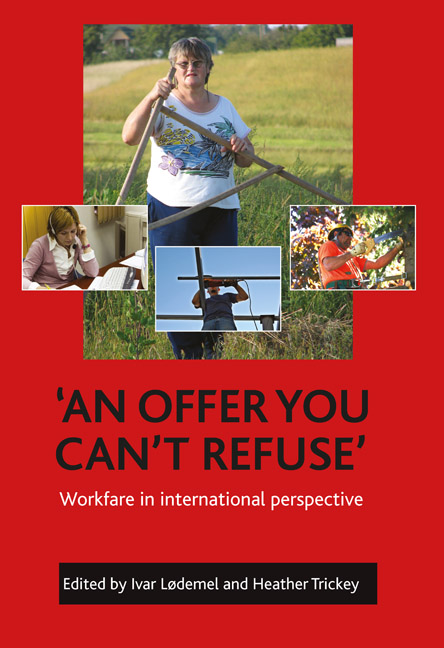Book contents
- Frontmatter
- Contents
- Acknowledgements
- Dedication
- Notes on contributors
- Preface
- one A new contract for social assistance
- two Between subsidiarity and social assistance – the French republican route to activation
- three Uneven development – local authorities and workfare in Germany
- four Workfare in the Netherlands: young unemployed people and the Jobseeker’s Employment Act
- five National objectives and local implementation of workfare in Norway
- six When all must be active – workfare in Denmark
- seven Steps to compulsion within British labour market policies
- eight Making work for welfare in the United States
- nine Comparing workfare programmes – features and implications
- ten Discussion: workfare in the welfare state
- Index
ten - Discussion: workfare in the welfare state
Published online by Cambridge University Press: 20 January 2022
- Frontmatter
- Contents
- Acknowledgements
- Dedication
- Notes on contributors
- Preface
- one A new contract for social assistance
- two Between subsidiarity and social assistance – the French republican route to activation
- three Uneven development – local authorities and workfare in Germany
- four Workfare in the Netherlands: young unemployed people and the Jobseeker’s Employment Act
- five National objectives and local implementation of workfare in Norway
- six When all must be active – workfare in Denmark
- seven Steps to compulsion within British labour market policies
- eight Making work for welfare in the United States
- nine Comparing workfare programmes – features and implications
- ten Discussion: workfare in the welfare state
- Index
Summary
Introduction
The main objective of this book has already been achieved. As a first systematic comparison of workfare programmes across several nations, the book has mapped variation among programmes in the seven countries studied and the main comparative findings are presented in Chapter Nine. Although future studies may arrive at descriptions and comparisons that deviate from the ones presented here, the material presented solidly builds on evidence about policy design and the aims of programmes expressed in legislation and statements from key policy makers in each of the seven countries. We shall now leave this solid ground in order to speculate on how the impact of the introduction of workfare can be assessed, and how the differences and similarities found among the seven programmes outlined in this book can be explained.
This chapter consists of three parts, each devoted to a question or an issue introduced in Chapter One. First, the extent to which the introduction of workfare programmes involves a change in social assistance towards either providing more or providing less to those targeted among the social assistance clientele. Second, the extent to which the evidence presented suggests a convergence of policies, or if the main picture is one of diversity. Finally, it explores different hypotheses which provide tentative explanations for the differences found between programmes.
In order to make the discussion feasible, this chapter focuses on one aspect of variation in the workfare programmes. This is the content of the programmes, described in Chapter Nine as strategy. This includes the selection of participants and the extent to which programmes individually tailor placements to the situation of each participant by offering options other than work alone. Variation in strategy was described as ranging from Human Resource Development (HRD) to Labour Market Attachment (LMA). In the first two parts of the chapter variation in the strategy of programmes is used to assess the change of the social assistance contract – described here as the more–less equation – and the extent of convergence. In these two parts, strategy is therefore considered mainly as an independent variable. In contrast, the third part discusses possible reasons for variation in strategy. The structure of this chapter is illustrated in Figure 10.1.
- Type
- Chapter
- Information
- An Offer You Can't Refuse'Workfare in International Perspective, pp. 295 - 344Publisher: Bristol University PressPrint publication year: 2001
- 1
- Cited by

